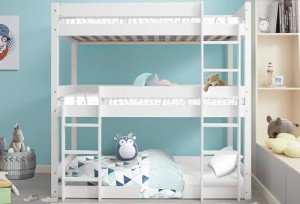What Is Bunk Beds Sale? History Of Bunk Beds Sale
Bunk Beds Sale: A Comprehensive Guide to Choosing the Right Bunk Bed for Your Home
Bunk beds have actually long been a staple in children's bed rooms, using a combination of space-saving effectiveness and enjoyable. Whether accommodating siblings, buddies on sleepovers, or just making the most of a playroom, bunk beds have ended up being a vital element in modern-day household homes. As sales on bunk beds rise, it becomes increasingly vital for consumers to make informed choices when acquiring one. This post will cover the essentials of purchasing a bunk bed, from types to safety features, in addition to ideas for preserving the stability of your investment.
Kinds Of Bunk Beds
When thinking about a bunk bed sale, it's important to comprehend the different designs readily available on the market. Below are the most common types:
Traditional Bunk Beds: These include 2 beds stacked one above the other, sharing a single frame. They are frequently the most affordable alternative.
L-Shaped Bunk Beds: This style includes one bed positioned vertically and another horizontally. This plan creates additional space underneath the upper bed, which can be used for storage or a backyard.
Lofted Beds: Similar to conventional bunk beds but with no lower bed. Instead, the space underneath can be used for a desk, play area, or extra storage.
Triple Bunk Beds: For families with a bigger number of kids or frequent pajama parties, triple bunk beds supply 3 sleeping areas in a space-efficient style.
Futon Bunk Beds: These styles merge bunk beds and futon couches. The bottom area transforms into a separate seating area, improving performance.
Convertible Bunk Beds: These beds can be separated into two private beds, making them versatile as kids's needs change with time.
Table 1: Comparison of Bunk Bed Types
Type
Description
Space Efficiency
Extra Features
Traditional Bunk Bed
Two beds stacked vertically
High
Simplest style
L-Shaped Bunk Bed
One vertical and one horizontal bed
Moderate
Play or storage space
Lofted Bed
Raised bed with open space below
High
Work/play area
Triple Bunk Bed
Three stacked beds
Really High
Accommodates more users
Futon Bunk Bed
Bunk bed with a convertible futon
High
Multi-functional
Convertible Bunk Bed
Can be split into two different beds
Moderate
Versatility & & longevity
Safety Features to Consider
Safety is vital when purchasing a bunk bed. Below are key safety features to look for:
Guardrails: Adequate guardrails ought to be present on both sides of the upper bunk to avoid falls. They ought to be at least 5 inches higher than the mattress.
Ladder Design: Look for tough, wide ladders with slip-resistant rungs. Make sure that the angle is not too high for easy gain access to.
Stability: Ensure the bed is constructed with strong products, such as strong wood or sturdy metal. The bed must not wobble when in usage.
Weight Limit: Check the weight capacity of the bunk bed to guarantee it can accommodate the designated users safely.
Material Safety: If possible, select beds made from non-toxic products or those satisfying security standards for children's furnishings.
Table 2: Essential Safety Features
Function
Description
Significance
Guardrails
Sides of upper bed to prevent falls
Necessary for kid safety
Ladder Design
Strong, slip-resistant rungs
Help safe and simple gain access to
Stability
Build quality to avoid wobbling
Guarantees security and durability
Weight Limit
Optimum weight capacity
Avoids accidents
Product Safety
Non-toxic, safe products
Protects children's health
Upkeep Tips for Bunk Beds
To extend the life of your bunk bed and guarantee ongoing safety, think about the following maintenance ideas:
Regular Inspections: Periodically examine the structure for loose screws, bolts, or any signs of wear. Tighten fasteners as needed.
Clean Periodically: Dust and tidy the surfaces frequently. Usage proper cleaners that will not damage the surface.
Check Weight Limits: Be conscious of weight limits, especially with older kids or adults who might want to use the upper bunk.
Avoid Climbing on Guardrails: Educate kids not to utilize guardrails for climbing up or playing to decrease the threat of mishaps.
Regularly Asked Questions (FAQs)
Q1: What is the age limitation for kids to securely use bunk beds?A: While it differs by the producer, lots of advise that kids under six need to not sleep in the upper bunk due to safety concerns.
Q2: How can parents discourage risky climbing?A: Setting clear rules about bunk bed usage and monitoring kids can help. Furthermore, utilizing a bed tent can dissuade climbing while developing a fun sleep environment.
Q3: What should I consider when embellishing a space with bunk beds?A: Ensure there suffices space around the bunk bed for safe movement, and make use of the decoration to develop individualized areas for each kid.
Q4: Is a lofted bed appropriate for older kids?A: Yes, lofted beds can be ideal for older children as long as they fulfill safety requirements and the child is accountable enough to use them safely.
Bunk beds serve a practical purpose while adding an element of enjoyable to a kid's bed room. As sales of bunk beds continue to increase, careful consideration of types, safety features, and maintenance practices is necessary for parents and caretakers. By comprehending what google did to me , families can discover the best bunk bed for their home, ensuring both usefulness and safety for years to come. Whether it's for brother or sisters sharing a space or developing a cozy sleepover space, a well-chosen bunk bed can provide happiness and practicality, making it a worthy investment.
